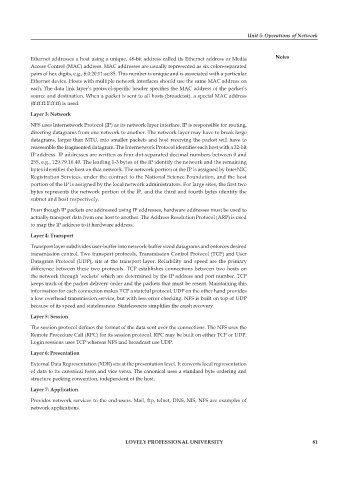Page 88 - DCAP104_EXPOSURE_TO_COMPUTER_DISCPLINES
P. 88
Unit 5: Operations of Network
Ethernet addresses a host using a unique, 48-bit address called its Ethernet address or Media Notes
Access Control (MAC) address. MAC addresses are usually represented as six colon-separated
pairs of hex digits, e.g., 8:0:20:11:ac:85. This number is unique and is associated with a particular
Ethernet device. Hosts with multiple network interfaces should use the same MAC address on
each. The data link layer’s protocol-specific header specifies the MAC address of the packet’s
source and destination. When a packet is sent to all hosts (broadcast), a special MAC address
(ff:ff:ff:ff:ff:ff) is used.
Layer 3: Network
NFS uses Internetwork Protocol (IP) as its network layer interface. IP is responsible for routing,
directing datagrams from one network to another. The network layer may have to break large
datagrams, larger than MTU, into smaller packets and host receiving the packet will have to
reassemble the fragmented datagram. The Internetwork Protocol identifies each host with a 32-bit
IP address. IP addresses are written as four dot-separated decimal numbers between 0 and
255, e.g., 129.79.16.40. The leading 1-3 bytes of the IP identify the network and the remaining
bytes identifies the host on that network. The network portion of the IP is assigned by InterNIC
Registration Services, under the contract to the National Science Foundation, and the host
portion of the IP is assigned by the local network administrators. For large sites, the first two
bytes represents the network portion of the IP, and the third and fourth bytes identify the
subnet and host respectively.
Even though IP packets are addressed using IP addresses, hardware addresses must be used to
actually transport data from one host to another. The Address Resolution Protocol (ARP) is used
to map the IP address to it hardware address.
Layer 4: Transport
Transport layer subdivides user-buffer into network-buffer sized datagrams and enforces desired
transmission control. Two transport protocols, Transmission Control Protocol (TCP) and User
Datagram Protocol (UDP), sits at the transport layer. Reliability and speed are the primary
difference between these two protocols. TCP establishes connections between two hosts on
the network through ‘sockets’ which are determined by the IP address and port number. TCP
keeps track of the packet delivery order and the packets that must be resent. Maintaining this
information for each connection makes TCP a stateful protocol. UDP on the other hand provides
a low overhead transmission service, but with less error checking. NFS is built on top of UDP
because of its speed and statelessness. Statelessness simplifies the crash recovery.
Layer 5: Session
The session protocol defines the format of the data sent over the connections. The NFS uses the
Remote Procedure Call (RPC) for its session protocol. RPC may be built on either TCP or UDP.
Login sessions uses TCP whereas NFS and broadcast use UDP.
Layer 6: Presentation
External Data Representation (XDR) sits at the presentation level. It converts local representation
of data to its canonical form and vice versa. The canonical uses a standard byte ordering and
structure packing convention, independent of the host.
Layer 7: Application
Provides network services to the end-users. Mail, ftp, telnet, DNS, NIS, NFS are examples of
network applications.
LOVELY PROFESSIONAL UNIVERSITY 81

